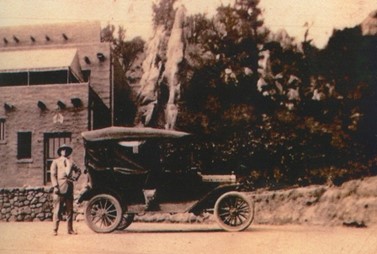
ADVENTURERS
Momís roller coaster ride began with an adventurous young man from Iowa who loved to dance.

John Scherer used to sneak out of town to dance because dancing was considered scandalous. One weekend he met a great dancer, Nellie Redinger, from across the border in Missouri. Mom retells their story: "The Redingers were Protestants of their own making, very strict on what young folks could do. Most of those from Iowa were Presbyterians. Nellie's sister, Pearl, played the organ in the Chapel in Ridgeway, Missouri. John's cousin's (Deyo) wife Erma played the organ at church for 50 years (Afton, Iowa). So the young people went across to Iowa to Mt. Ayr for dancing. A big no, no. That could be where Nellie met John and Blanche and Clarence. They talked about having lots of fun dancing there. And in Long Beach went to a big dance each Saturday night." [Deyo took his wife, Erma, to Long Beach on their honeymoon in 1919 and joined John and Nellie at the dances in Long Beach.] They loved dancing together and dreaming up adventures. Soon they decided to be married, so they planned a Christmas wedding on Johnís 21st birthday, December 25, 1913. Nellieís brother, Frank, the Presbyterian preacher, presided. Read more details form Helen's notes from this period.

Nellie was a spectacular bride decked out in the dress, trimmed with white fir for a winter wedding, that her Mom and sisters had made. After the wedding John and Nellie spent a few years on the farm saving money for their first adventure, a trip from Missouri to California in a Model T Ford. Mom wrote: "My mother was 20 on October 5, 1913. They went to live on the Scherer farm and got paid so much a month. They save and saved and saved. Talking about a Model T and going to Colorado Springs. Nellie didn't know she was going to California until they left the farm May 1916. I tried to figure out about how much cash they had when they left Missouri and the highest I could come up with was $1,930 ($1,730 for three years work; gift from Redingers $200). Gasoline is 10 cents per gallon, water is free, oil is 5 cents a quart. Then there were other expenses: repair kit for times, tire boots, hub cap grease, battery, gas cans, water bags. Quilts and feather beds were from the Redingers.

It was May 1916 and there was no paved highway to California, so they followed the railroad tracks. The Lincoln Highway was under completion but wasn't much better than the tracks and trails that John and Nellie followed.
According to the Association's 1916 Official Road Guide a trip from the Atlantic to the Pacific on the Lincoln Highway was "something of a sporting proposition" and might take 20 to 30 days. To make it in 30 days the motorist would need to average 18 miles (29 km) an hour for 6 hours per day, and driving was only done during daylight hours. The trip was thought to cost no more than $5 a day per person, including food, gas, oil, and even "five or six meals in hotels". Car repairs would, of course, increase the cost. Since gasoline stations were still rare in many parts of the country, motorists were urged to top off their gasoline at every opportunity, even if they had done so recently. Motorists should wade through water before driving through to verify the depth. The list of recommended equipment included chains, a shovel, axe, jacks, tire casings and inner tubes, tools, and (of course) a pair of Lincoln Highway pennants. And, the guide offered this sage advice: "Don't wear new shoes". Firearms were not necessary, but west of Omaha full camping equipment was recommended, and the guide warned against drinking alkali water that could cause serious cramps. In certain areas, advice was offered on getting help, for example near Fish Springs, Utah, "If trouble is experienced, build a sagebrush fire. Mr. Thomas will come with a team. He can see you 20 miles off". Later editions omitted Mr. Thomas, but westbound travelers were advised to stop at the Orr's Ranch for advice, and eastbound motorists were to check with Mr. K.C. Davis of Gold Hill, Nevada. (Wikipedia)
They must have been quite a sight with extra tires strapped to the sides and rear end, canvas sacks filled with water hanging from the front and back, and a pile of luggage in the back seat with a feather bed, quilts, and a canvas piled on top. They were young and full of adventure.


The first half of the trip from Missouri to Colorado Springs was challenging. The second half was crazy. Nellie was tough but even she cried when they nearly died of thirst crossing the desert. She was relieved when John refused to sell her to the Indians. In final desperation they both pushed the Model T from the desert floor up the steep mountain grades into California.


John and Nellie quickly put the rough journey behind them as they fed the birds and waded through the waves in Long Beach. Mom recalled: "My Mother loved the ocean but not like my Dad. He would go past the breakers with a straw hat on and swim back and forth, amazing to watch." John found work in the ship yards then opened the Arcade Meat Market on West Broadway.

Nellie worked side by side with John. She was also an expert butcher. Soon they had saved enough money to buy their first home on Daisy Ave. Mom writes: "Now they were ready for their next adventure". They also continued to open more stores.




812 Daisy Ave. with Nellie Scherer holding baby Helen